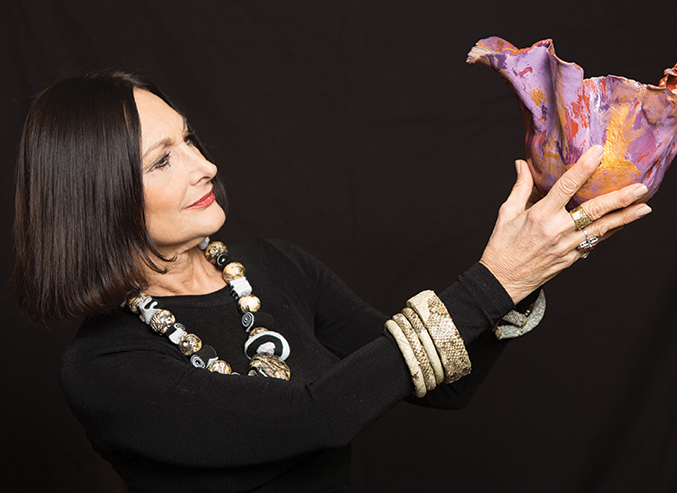The artistry begins even before you enter Gina Bratter’s home.
While her corner townhouse might seem like any of the endlessly similar facades in the Dobbs Ferry complex, a collection of decorative tiles and tiny sculptures gives the entrance a distinct personality.
And when the artist opens the door, with a warm smile and hand extended, you are swept into a space where nearly every inch is filled with art. There are masks and paintings dotting the rice-paper walls and bowls, dolls and assorted sculptures artfully filling most every surface.
It overwhelms – but in an exciting sense.
“Most of it is mine,” Bratter says in response to a show of amazement she has likely encountered before. “It’s my little cocoon.”
The Italian-born artist will offer espresso – “I don’t know how to make American coffee” – before settling into the living room to chat about her life in art.
Bratter is clearly at home within a space that showcases her own work liberally sprinkled within an array of African masks and even an intricately carved Flemish cabinet purchased in an antiques shop.
“I appreciate art from all over the world,” she says, with her own imagery ranging from Japanese figures to Italian villages.
Her striking appearance is an equal reflection of her art.
“I make my own jewelry. I decorate my shoes. I make my own sweaters,” she says. Indeed, on this day she wears a sweater and jewelry of her own design, with shoes she has embellished.
And while there is a traditional studio space on the home’s top floor, Bratter says her work is done throughout.
“Every room has become a studio.”
Or a project: “I decided one day I didn’t like the color of my kitchen. I painted the tiles.”
EARLY DAYS
It’s always been an artistic life for Bratter, even if she had to fight for it once her family arrived in New York City.
“I grew up in a very creative home. I was born in Italy. When I came to this country, art was just not in the equation. …Education was stressed.”
Bratter’s parents were scholarly people with a talent for tailoring. The Amalgamated Clothing Workers of America sponsored the family’s trip to America, with the contract specifying that the adults in the family would then work for the union. Her parents and brother, 12 years her senior, would travel from the outer boroughs to Greenwich Village for work (with her brother attending college at night).
This left the 8-year-old home alone, with her parents asking a landlady to check in on her from time to time, “simply the only option they had to keep me safe.”
She says she realizes that her parents were facing a “whole different way of life for us, and the unknown was very frightening for them.”
Bratter would take newspapers and make dolls, sketches and papier-mâché, “stuff that I don’t know where it came from but it saved my life,” helping her escape the “terrible fear” of being abandoned.
“I survived it, and it was because of my art,” she says. “This continued to be a pattern … I was a very depressed teenager. I come from a family who are all geniuses and I said, ‘Where do I fit in?’”
A high school teacher recognized Bratter’s artistic talent, with Bratter eventually earning recognition through a national competition.
“I would earn all of these medals and my parents would never come to see me get my medals,” she says.
Bratter says, though she might wear “sandals up to my knees” and “hair like Cher,” she led a conventional life that defied the stereotype of a 1960s artist.
She would go on to college – “nothing to do with art” – but art never left her thoughts.
“Whenever I had a bad day, I would get in my car. I would drive around.”
One day driving by the Garrison Art Center, she happened upon a scene that would change her life.
“I saw all of these beautiful colors on a clothesline.”
She went in, learned they were batik works and took a class later that same day.
“I fell totally in love with the technique,” she says. “As a result of that, I was creating like a lunatic.”
She would go on to develop an innovative way to create batik – a process that uses wax-resist dyeing on cloth to make art – effectively westernizing the ancient art form and bringing it to a whole new audience.
“I decided why not try it on rice paper,” Bratter says of her breakthrough approach to the process.
She would begin exhibiting locally and was at a White Plains furniture store with a friend – “I was teaching belly dancing at the time” – when she met an agent who would change her path.
“He made me very famous in a very short period of time. That really launched my career,” she says.
The work – creating pieces under her then-name Gina Lombardi to complement trends in furniture – would also make her career.
She was creating commissioned works that were reproduced in lots of 500 or more. Finally, her parents recognized her talent.
“They finally accepted it at that point,” she says.
The work, though, was not as creative as she might have liked.
“So much of what I did was for what the home décor field called for,” she says.
Her agent would tell her, for example, that the following season would focus on Asian furniture.
“He would say to me, ‘It’s going to be big so create some pieces.’”
The work gave her both a “name and income” that helped with her raising two children. (She is also grandmother of three).
Bratter, though, didn’t create in order to gain recognition or fame.
“It’s whether you consider yourself famous or not,” she says of her time during that era. “It was openings of galleries. It was hanging out at galleries with Peter Max, Andy Warhol.”
Bratter created an extensive number of original works, printing them at prestigious city spots where work by fellow artists including LeRoy Neiman, Erté and Chuck Close were also completed. During her downtime, she took courses at The Parsons School of Design and would become accredited to teach, which she did in the New York City public schools – ironically, Italian, math and “everything but art.”
Eventually, she would land at Southern Westchester BOCES where she taught a variety of subjects, including fashion design, for 18 years.
“Then I retired and decided to just devote my time to… ” she says, gently waving her arm to everything in the room. “This is my oxygen. It’s my passion.”
MOVING FORWARD
“Now I’m free to design any way, and create any way I want,” she says. “I go through these periods. For six months I design pottery. For six months I’ll design clothes. It’s great to have that kind of freedom in my life.”
After all, “If we can find a way of transporting us into a world where there’s beauty and color and nature – then we have to grab that gift and run with it.”
In recognition of that gift, she donates 10 percent of all her proceeds to a variety of charitable and nonprofit causes.
Once again, she has found herself teaching.
“I’m teaching watercolors to adults right here in my dining room,” she says. Beading classes are also offered.
She welcomes participants of all skill levels, encouraging them to be daring.
“I’m very unconventional when it comes to my art,” Bratter says.
She has been known to take a work and run it under water to create an unusual effect or splatter something with paint as ways to encourage students to experiment.
“I think it’s to show them you can’t fear. … It’s a piece of paper.”
Her unique approach is also evidenced in a showroom on the ground floor, a virtual explosion of jewelry and accessories of every kind.
“Now, you will understand,” she says, opening the door to the treasure trove. “I don’t make two of a kind. I’d go crazy.”
It is like nothing you’ve seen before.
“I don’t want to create what people can buy in a store,” she says, explaining the incredible spectrum of work in metals, clay, glass, beads, leather and fibers.
Friends often come and ask to borrow something for a special occasion, and she also opens up shop for seasonal boutiques.
Over time, Bratter has had trouble with her hands, from carpal tunnel syndrome to a hereditary muscle condition.
She dreads the idea of her hands becoming impaired.
“That is my biggest fear,” she says. “If I didn’t create, what would I do?”
She never fears running out of inspiration, though.
“The truth is what keeps us creating is we never reach that ultimate masterpiece. It’s the process. It’s the total meditation that’s involved. It does become a form of meditation.”
Talking about her annual return to Sicily puts a smile on Bratter’s face.
“My brother moved back. I have been going as long as I was old enough to travel by myself, since age 12. The last day of school I was on a plane.”
Once there, usually each June to September, she takes advantage of her surroundings.
“It’s outdoor living,” she says, where she can focus on larger-scale projects such as felting and weaving.
It is, she admits, a lovely complement to life in the Hudson Valley.
“I’m fortunate that I can do both.”
Bratter may have made her name in the world of commercial art, but today, perhaps more than ever, her art reflects her soul.
“I did those conventional things to make a living. Now I can be free, be me.”
And that creativity is part of her every moment, she says.
“Even people now say, ‘What a wonderful hobby.’ Hobby? It’s my life.”
And you can tell, it truly is.
For more, contact Gina Bratter at ginabratter@hotmail.com.




